蘇門答臘中部Panti早始新世S型花崗巖地球化學特征及其新特提斯構造意義
余小清, 錢 鑫*, 張玉芝, 徐 暢, 王岳軍
蘇門答臘中部Panti早始新世S型花崗巖地球化學特征及其新特提斯構造意義
余小清1, 2, 錢 鑫1, 2*, 張玉芝1, 2, 徐 暢1, 2, 王岳軍1, 2
(1.廣東省地球動力作用與地質災害重點實驗室, 中山大學 地球科學與工程學院, 廣東 廣州 510275; 2.南方海洋科學與工程廣東省實驗室, 廣東 珠海 519082)
蘇門答臘地處特提斯構造域與印度洋島弧系統之內, 區內廣泛發育中?新生代火成巖。這些火成巖對特提斯構造帶的延伸及界定具有重要意義, 但目前對于蘇門答臘島的研究程度較低。本文選取蘇門答臘島中部Panti地區的花崗巖進行了巖相學、鋯石年代學、鋯石原位Hf同位素和全巖地球化學研究。年代學研究表明, Panti花崗巖鋯石U-Pb年齡為55.5±0.3 Ma。該套花崗巖具有高SiO2(76.61%~78.37%)和高堿(Na2O+K2O=7.47%~8.21%)的特征, 其分異指數(DI)為95~96, A/CNK為1.08~1.12, 為高分異S型花崗巖。稀土配分模式圖及微量元素蛛網圖顯示其具有強烈的Eu負異常(Eu/Eu*=0.04~0.05), 并虧損Nb、Ta、Sr、P和Ti的特征。且該套花崗巖還具有高Rb/Sr和低CaO/Na2O 值, 同時顯示富集的鋯石Hf同位素組成(Hf()=?9.1~?2.6)和較老的Hf二階模式年齡(DM2=1.29~1.70 Ga), 這些特征均指示該套花崗巖來源于古老的變泥質巖的部分熔融。對比緬甸?滇西?藏南一帶同時期的巖漿事件, 我們認為Panti早始新世高分異S型花崗巖可與滇西騰梁和東盈江同時期花崗巖進行對比, 指示了新特提斯構造巖漿帶南延至蘇門答臘中部。
蘇門答臘中部; 早始新世; 高分異S型花崗巖; 鋯石U-Pb年代學; 地球化學; 新特提斯
0 引 言
早白堊世開始, 隨著新特提斯洋的俯沖, 印度板塊與歐亞板塊碰撞, 形成了全球范圍內最為壯觀的喜馬拉雅造山帶(Yin and Harrison, 2000)。喜馬拉雅造山帶構造地質學、年代學及巖漿巖巖石學的研究對理解新特提斯洋的俯沖閉合過程及不同塊體的碰撞拼合演化歷史具有重要意義(Xu et al., 2012)。目前, 大量研究表明位于班公?怒江與雅魯藏布江之間的岡底斯造山帶(即拉薩地塊南緣)與新特提斯洋的俯沖閉合相關(Chung et al., 2005; Chu et al., 2006; Wen et al., 2008; 朱弟成等, 2008; Zhu et al., 2011)。岡底斯造山帶向東可以延伸到藏東南波密?察隅地區(Liang et al., 2008), 之后向南轉入滇西的高黎貢?騰沖?梁河?盈江一帶(Xu et al., 2012; 馬莉燕, 2013; 馬莉燕等, 2013; Ma et al., 2014; Wang et al., 2014), 經緬甸的抹谷變質帶(Barley et al., 2003; Searle et al., 2007; Mitchell et al., 2007; Mitchell et al., 2012)南延至蘇門答臘島(Mitchell, 1993; Barley et al., 2003)。也有學者認為西緬甸的白堊紀?始新世巖漿弧是岡底斯帶的延伸, 為新特提斯巖漿帶在東南亞的延伸(Wang et al., 2014b)。
東南亞地區是晚古生代或早中生代期間由岡瓦納北緣分離出來的陸塊, 隨古特提斯洋俯沖消減拼貼至歐亞大陸東南緣形成的(Metcalfe, 1996; Wang et al., 2018)。其中蘇門答臘島呈NW-SE向狹長分布于東南亞西南岬角, 并被劃分為東蘇門答臘、西蘇門答臘和Woyla地體, 三者分別沿中央構造帶和Woyla 縫合線拼貼(圖1a、b)。現有研究認為西蘇門答臘在中?晚泥盆世期間, 隨著古特提斯洋打開, 與西緬甸和華夏陸塊從岡瓦納古陸北緣向北裂離。早二疊世期間, 受古特提斯洋的俯沖作用, 西蘇門答臘發育安第斯型巖漿弧(Barber and Crow, 2003)。而有的學者認為, 隨著東古特提斯洋的俯沖, 東蘇門答臘地塊于中三疊世拼貼至印支地塊, 構成了滇緬馬蘇(Sibumas)地塊的一部分(Barber and Crow, 2003, 2009; Wang et al., 2018)。晚中生代, Woyla地體形成, 隨著特提斯洋俯沖, 其與蘇門答臘主體拼貼(Barber and Crow, 2003)。最近研究表明蘇門答臘島中部地區保存有與新特提斯洋演化有關的始新世碎屑鋯石, 證明了新特提斯構造帶可以延伸至蘇門答臘島內(Zhang et al., 2019)。此外, 蘇門答臘島的古地磁數據也顯示蘇門答臘島Woyla帶是藏南地區與新特提斯洋俯沖相關的Incertus洋內弧的南延(Hall, 2012)。但上述研究均集中于沉積巖及古地磁方面, 缺少對相關巖漿巖年代學和地球化學的研究, 因此限制了我們對新特提斯構造帶延伸及演化的認識。近期本課題組在蘇門答臘島進行的野外地質調查中, 在中部Panti地區識別出一套始新世花崗巖。本次研究將以這套花崗巖為研究對象, 系統開展巖相學、鋯石年代學、鋯石原位Hf同位素及全巖地球化學研究, 闡明其巖石成因及構造背景, 進而與區域相關火成巖進行對比, 為新特提斯巖漿帶的延伸提供新的證據。
1 地質背景及巖相學特征
蘇門答臘的大陸基底被認為由結晶片巖、前石炭紀的沉積單元及時代相當的侵入體組成(Hamilton, 1979)。自古近紀中期起, 印度洋沿巺他海溝斜向俯沖, 在蘇門答臘西海岸形成從北西至南東的巨型巴里桑山火山弧, 該火山弧被NW-SE右型走滑斷層體系(巺他斷層區)切分成多個狹長地塊(圖1b; 如Mccourt et al., 1996; Barber et al., 2005)。蘇門答臘島前新生代地層主要劃分為石炭系?二疊系Tapanuli群、二疊系?三疊系Peusangan群和侏羅系?白堊系Woyla群(Cameron et al., 1980), 且大部分地區被新生代沉積巖和火山巖覆蓋。其中西蘇門答臘分布有石炭紀地層, 并發育親華夏體系的低緯度暖水動植物群?熱帶維憲期珊瑚藻動植物群(Barber and Crow, 2009)。而東蘇門答臘分布有二疊紀地層, 發育高緯度的冷水動物群, 且分布有與錫礦相關的花崗巖(Cobbing, 2005; Barber and Crow, 2009)。至少在晚三疊世前, 西蘇門答臘和西緬甸沿中央構造帶拼貼至東蘇門答臘(滇緬馬蘇地塊西部), 并在中央構造帶發育一系列的ES向地塹構造, 且形成盆地(Barber and Crow, 2003)。關于Woyla地體的形成, 有人認為其是晚侏羅世特提斯洋俯沖形成的洋內島弧和增生雜巖體, 并隨著白堊紀特提斯洋閉合拼貼至西蘇門答臘(Wajzer et al., 1991; Barber, 2000; Barber and Crow, 2003; Barber et al., 2005), 包含北部的西庫萊(Sikuleh)和中部的納塔爾(Natal)2個古老微陸塊(Barber, 2000; Barber et al., 2005); 也有學者認為這些微陸塊是在晚侏羅世由澳大利亞裂離而來的(Metcalfe, 1993)。此外Woyla地體還包括了新生代的火山弧巖漿巖(玄武?安山質火山巖和火山碎屑巖等)、海洋增生雜巖(枕狀玄武巖和紅色頁巖等)和中侏羅世?早白堊世的雜巖(石英鈣質砂頁巖)等(Advokaat et al., 2018)。中新世, 隨著蘇門答臘北部安得曼海的打開, 西蘇門答臘和西緬甸逐漸分離(Barber et al., 2005; Barber and Crow, 2008, 2009; Metcalfe, 2011, 2013)。
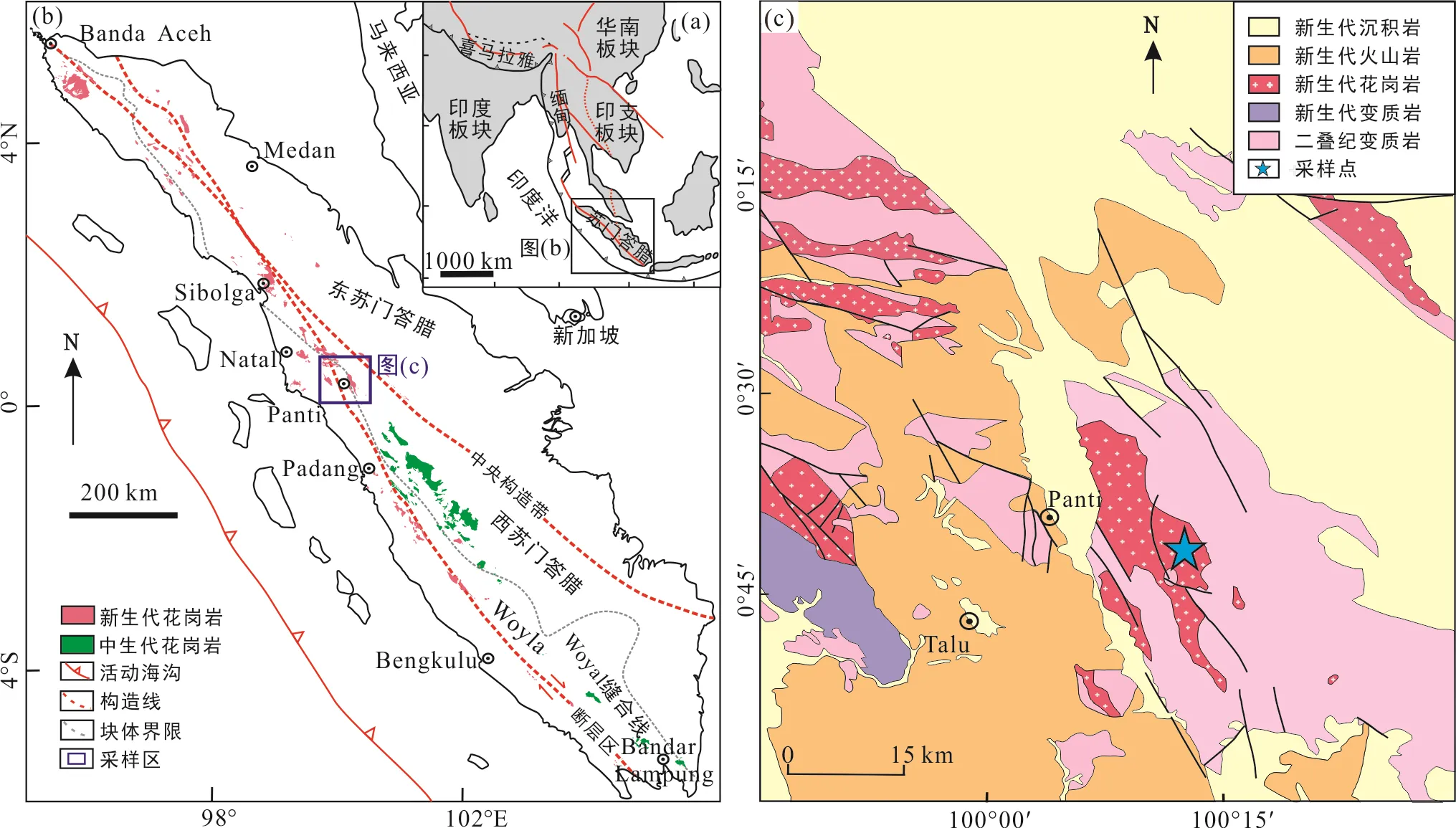
圖1 蘇門答臘區域構造圖(a、b)和研究區地質簡圖(c)(據Barley et al., 2003; Advokaat et al., 2018)
Panti花崗巖位于蘇門答臘島中部, 處于西蘇門答臘與Woyla地體交界處。研究區還出露有大量新生代沉積巖和火山巖, 其中沉積巖包括新近紀石英砂巖、碳質頁巖、海綠石頁巖、粉砂巖、礫巖和第四紀砂巖; 火山巖主要為中新世層狀火山巖、第四紀熔巖及火山碎屑巖為主的沖積層。區內新生代花崗巖普遍侵入二疊紀的板巖、變石英砂礫巖、變石英巖和千枚巖等變沉積巖中, 部分侵入至新生代的變火山巖、變雜砂巖、綠片巖、千枚巖和板巖中(圖1c)。
本次研究的花崗巖樣品采自Panti東邊約6 km處的TANDUNGK UMBANG 花崗巖巖體(坐標為: 00°22′57.25″S、100°07′04.02″E)。Panti花崗巖主要礦物為石英(40%~50%)、斜長石(20%~25%)和堿性長石(20%~30%), 次要礦物有黑云母(5%~8%), 可見少量鋯石副礦物(1%~2%), 其中堿性長石中含較多呈條紋結構的條紋長石, 斜長石發育聚片雙晶(圖2)。
2 分析方法
2.1 LA-ICP-MS鋯石U-Pb定年及原位Hf同位素測定
鋯石U-Pb同位素定年和原位微區微量元素含量分析在中山大學地球動力作用與地質災害省重點實驗室利用激光剝蝕系統與電感耦合等離子體質譜儀聯用(LA-ICP-MS)完成。GeolasHD激光剝蝕系統由COMPexPro 102 ArF 193 nm準分子激光器和MicroLas光學系統組成, ICP-MS型號為iCAP RQ。分析采用的激光束斑為32 μm, 頻率為5 Hz。U-Pb同位素定年采用鋯石標樣91500和Ple?ovice來進行同位素分餾校正, 采用玻璃標準物質NIST610進行微量元素校正。對分析數據的處理采用軟件GLITTER(Griffin et al., 2008)進行。
鋯石Hf同位素原位分析是在中山大學地球動力作用與地質災害省重點實驗室利用Geolas HD準分子ArF激光剝蝕系統通過Neptune Plus多接收器電感耦合等離子體質譜儀(MC-ICP-MS)完成。采用44 μm的激光斑束直徑和8 Hz的激光頻率剝蝕鋯石, 詳細的儀器參數和程序見Hu et al. (2012)。以91500和Ple?ovice作為標樣監測數據質量。Hf的初始同位素值是使用1.867×10?11a?1的176Lu衰變常數計算的(S?derlund et al., 2004)。使用176Hf/177Hf=0.283250和176Lu/177Hf=0.0384(Griffin et al., 2000)計算相對于虧損地幔的Hf模式年齡(DM), 并以大陸地殼平均值176Lu/177Hf=0.015(Griffin et al., 2002)計算Hf的二階模式年齡(DM2)。
2.2 主量、微量元素分析
選用新鮮樣品碎至200目用于全巖主量、微量測試。全巖主量、微量元素分析均在中山大學地球動力作用與地質災害省重點實驗室完成。主量元素分析在ARL-Perform’X4200型X射線熒光光譜分析儀(XRF)上測試完成。樣品制備采用熔片法, 將烘干后的樣品與硼酸鋰混合熔劑稱量至坩堝中, 加入飽和碘化銨(NH4I)溶液, 在鉑金坩堝中加熱至1050 ℃共熔制成熔片, 熔片方法參考Claisse et al. (2006), 分析精度優于1%。微量元素分析利用iCAP RQ型ICP-MS完成。儀器分析精度一般優于5%, 用高純度HNO3和HF對樣品進行初步溶解后再高溫溶解, 待樣品溶液冷卻后加入HNO3和內標溶液進行測試。
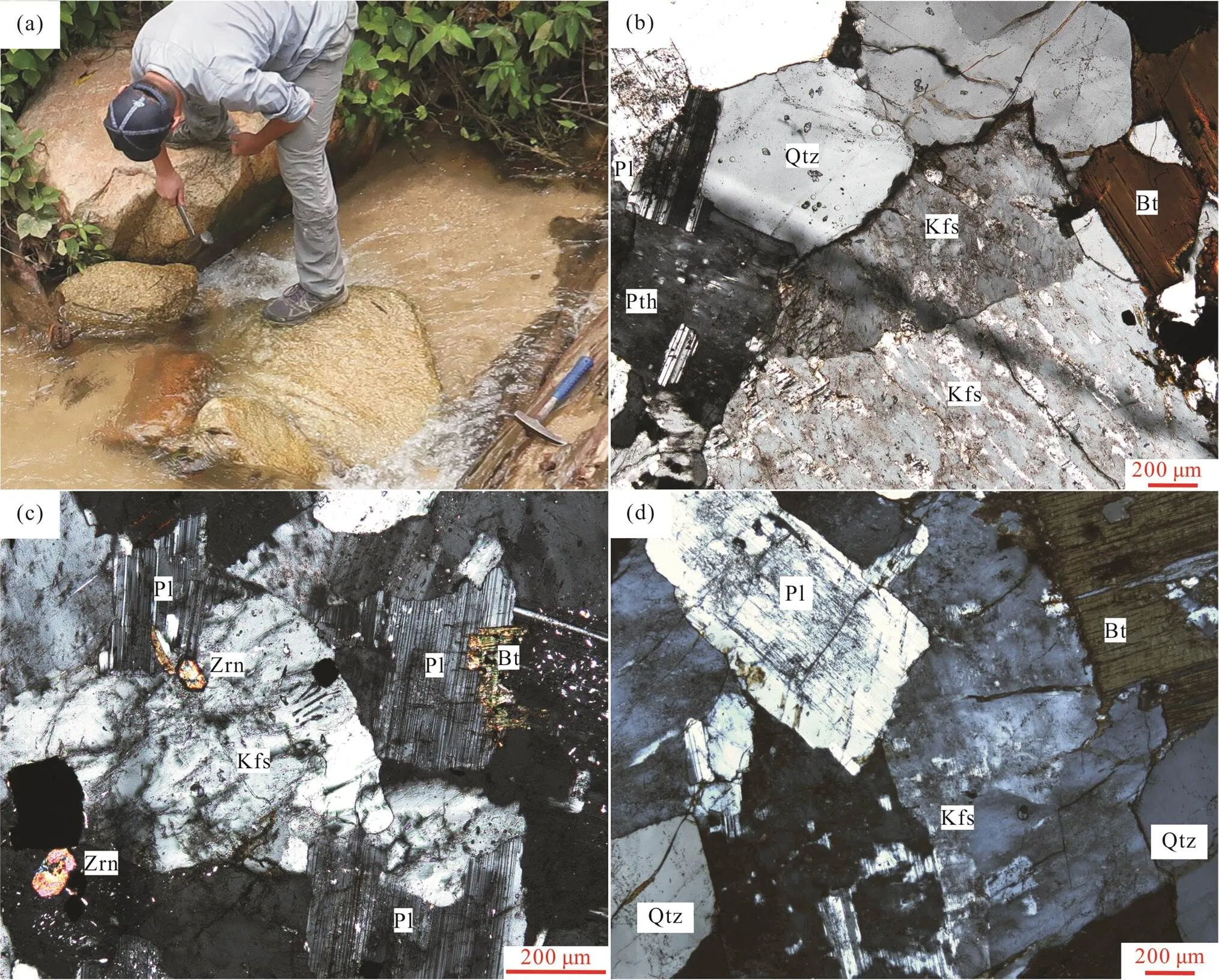
礦物代號: Qtz. 石英; Pl. 斜長石; Bt. 黑云母; Kfs. 鉀長石; Pth.條紋長石; Zrn. 鋯石。
3 分析結果
3.1 鋯石U-Pb年齡及Hf同位素特征
樣品18SM-40-1的30顆鋯石U-Pb測試結果見表1。CL圖像表明鋯石具有弱的振蕩環帶(圖3), 鋯石的Th/U值在0.19~0.34之間, 平均為0.25。所測鋯石點諧和度較好, 樣品點均落在諧和線上, 其206Pb/238U加權平均年齡為55.5±0.3 Ma(2σ, MSWD= 0.87,=30; 圖4)。在鋯石U-Pb測試的相同位置點上進行了原位的Hf同位素分析(表2), 所獲得的176Lu/177Hf 值為0.003195~0.006121,176Hf/177Hf 值為0.282486~0.282671, 對應的Hf()值為?9.1~?2.6, 二階模式年齡(DM2)為1.29~1.70 Ga。樣品落入滇西東盈江和南緬甸始新世花崗巖的Hf同位素組成區域內(圖4c; Xu et al., 2012; Li et al., 2019)。
3.2 巖石地球化學特征
Panti花崗巖樣品主量、微量元素測試結果見表3。樣品燒失量(LOI)均小于0.6%(0.34%~0.54%), 具有高SiO2(76.61%~78.37%)含量, 其CaO(0.26%~0.39%), Fe2O3(1.21%~1.54%), MgO(0.03%~0.05%), TiO2(0.08%~ 0.1%)和P2O5(0.01%~0.02%)含量均較低。樣品CIPW標準化礦物含石英(37%~44%), 正長石(26%~33%), 鈉長石(20%~32%), 鈣長石(1%~2%)和剛玉(1%~1.3%)。通過標準礦物在QAP三角圖解投點(圖5a), 樣品均落在二長花崗巖區域。其鋁飽和指數A/CNK值為1.08~1.12, A/NK值為1.14~1.18。在A/NK-A/CNK圖解中, 均顯示過鋁質的特征(圖5b)。樣品全堿含量較高(K2O+Na2O=7.47%~8.21%), 并具高K2O/Na2O (1.18~2.21)值, 在K2O-SiO2圖解中, 落入高鉀鈣堿性系列(圖5c)。總體上樣品主量元素特征與滇西和南緬甸始新世花崗巖類似(圖5; 趙少偉等, 2017; Li et al., 2019),分異指數DI(DI=Q+Or+Ab+Ne+Lc+Kp)值較高, 為95~96, 表明Panti花崗巖具有高分異的特征。
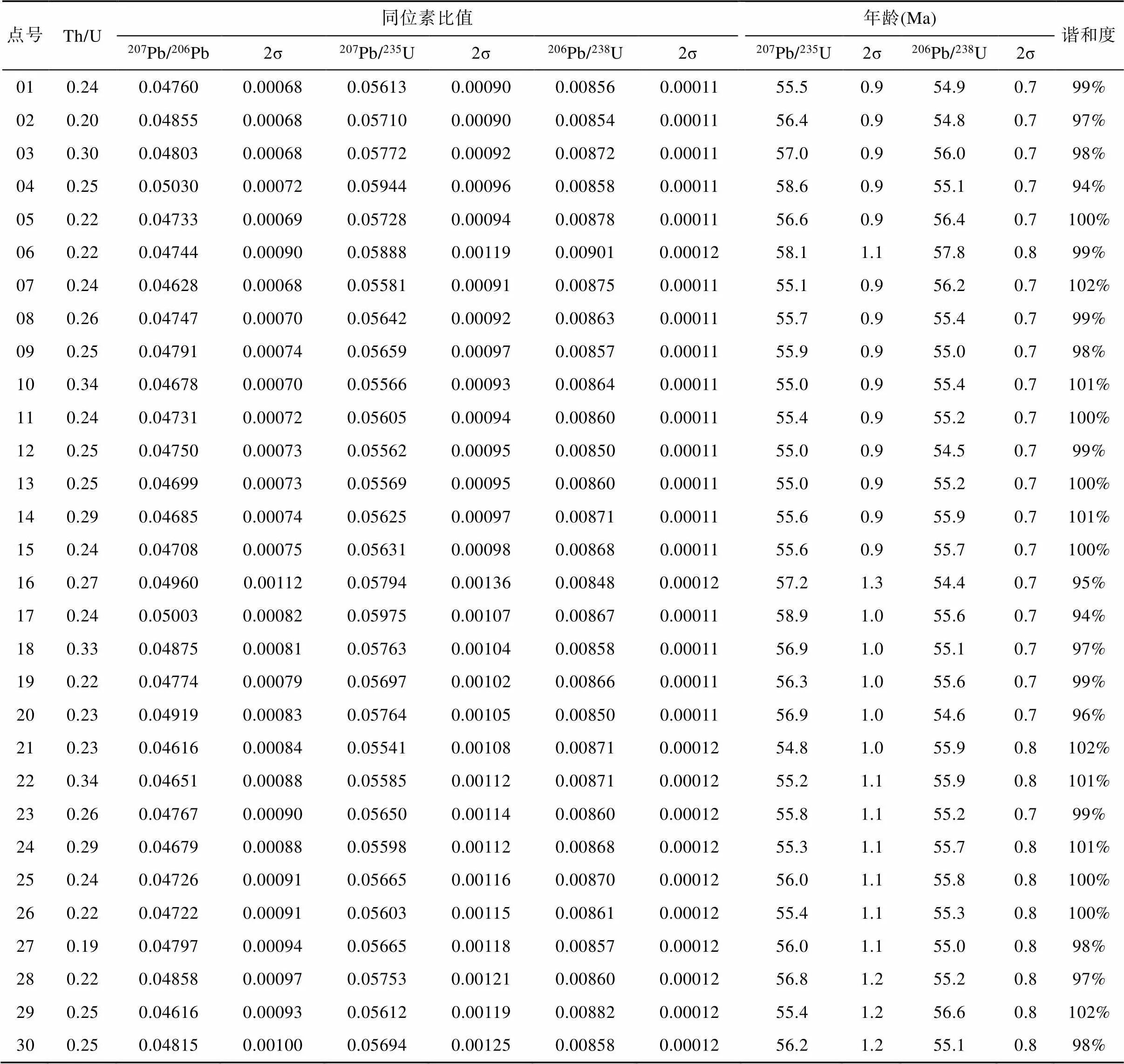
表1 Panti花崗巖(18SM-40-1) LA-ICP-MS鋯石測試分析結果

圖3 Panti花崗巖樣品代表性鋯石顆粒的陰極發光圖像
Panti花崗巖稀土元素總量(ΣREE)為160×10?6~342×10?6。在球粒隕石標準化稀土元素配分圖解上(圖6a)顯示輕稀土元素富集, 重稀土元素虧損的右傾型模式, (La/Yb)N為6.05~20.79, (Gd/Yb)N為1.46~2.51, 且具強烈的Eu負異常(Eu/Eu*=0.04~0.05)。在原始地幔標準化的微量元素蛛網圖中(圖6b), 樣品顯示富集大離子親石元素Rb、U和K, 而虧損高場強元素Nb、Ta和Ti的特征, 同時可見明顯的Sr負異常, 且樣品顯示高Rb/Sr和低K/Rb值的高分異特征。此外, 樣品Nb/Ta值為10~13(<5); 稀土元素四分組強度TE1, 3為0.97~1.02(<1.1), 應該是無流體相的單一體系下花崗質巖漿正常分異結晶形成的高分異花崗巖(陶繼華等, 2013; Ballouard et al., 2016)。稀土元素配分模式和微量元素蛛網圖顯示Panti花崗巖與滇西和南緬甸始新世花崗巖特征類似(趙少偉等, 2017; Li et al., 2019)。

圖c中數據來源: 蘇門答臘據Zhang et al. (2019); 滇西東盈江據Xu et al. (2012); 南緬甸據Li et al. (2019); 岡底斯帶親緣、北巖漿帶親緣據Zhang et al. (2017)。
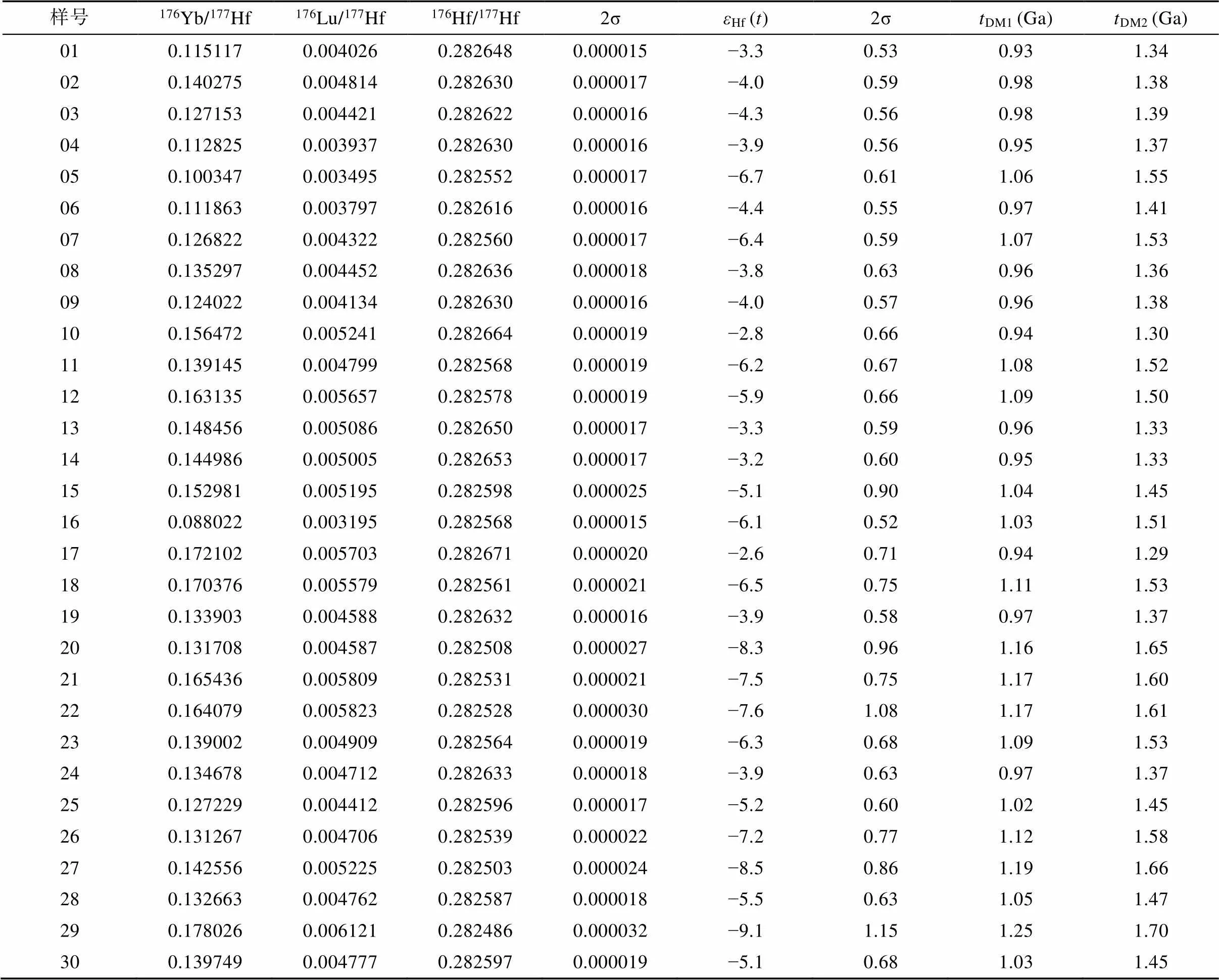
表2 Panti花崗巖(18SM-40-1)鋯石Hf同位素分析結果
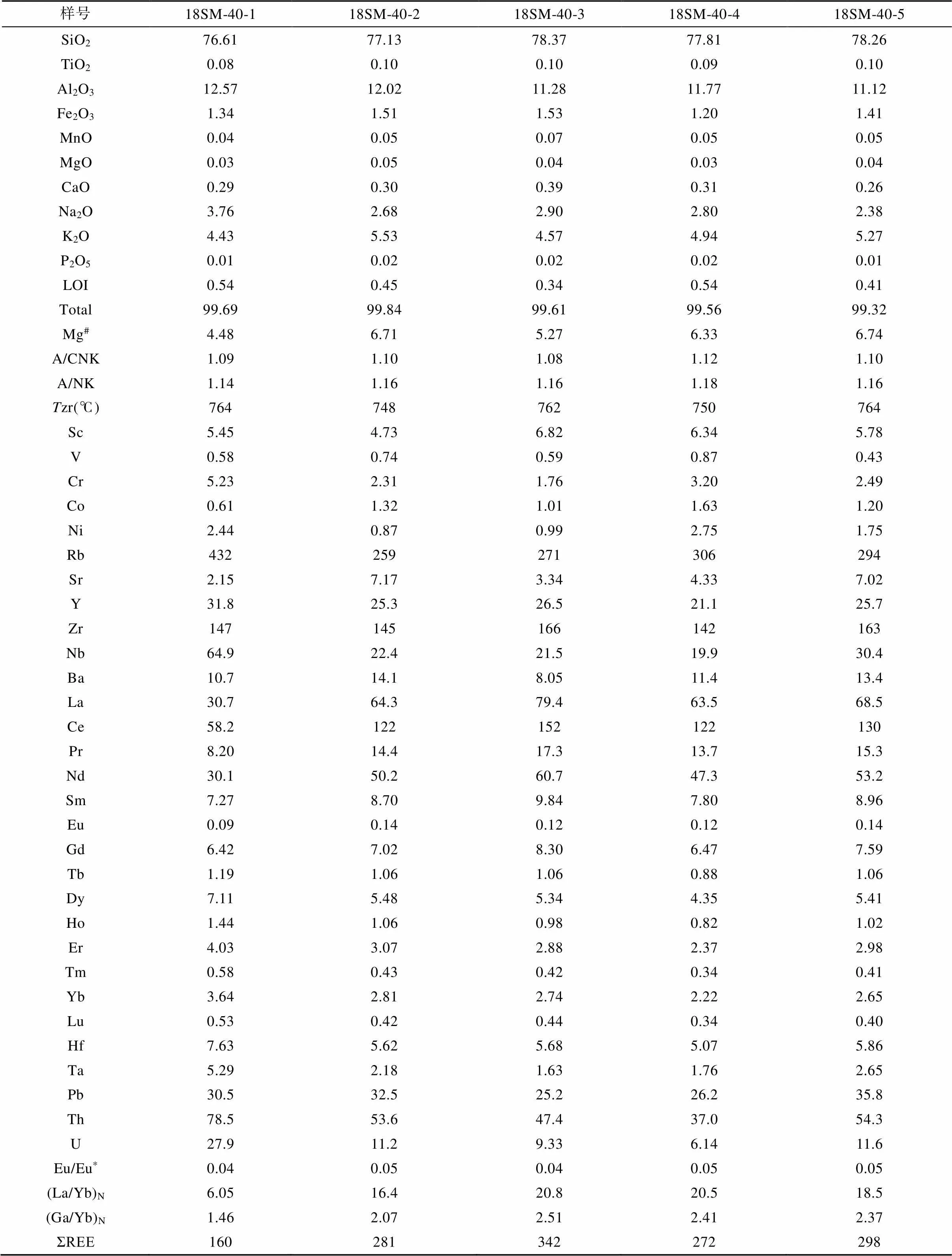
表3 Panti花崗巖主量(%)和微量元素(×10?6)組成
注: A/CNK=Al2O3/(CaO+Na2O+K2O); A/NK= Al2O3/(Na2O+K2O)。

圖5 Panti花崗巖的QAP (a)、A/NK-A/CNK (b)和K2O-SiO2 (c)圖解

圖6 Panti花崗巖球粒隕石標準化稀土元素配分曲線(a)和原始地幔標準化微量元素蛛網圖(b)(球粒隕石和原始地幔標準化數據引自Sun and McDonough, 1989)
4 討 論
4.1 巖石成因
Panti花崗巖具有較低的Ga、Zr、Nb等高場強元素組成, 其10000×Ga/Al為1.87~2.44, Zr含量為142×10?6~166×10?6, Zr+Nb+Ce+Y平均含量為327×10?6, 均低于Whalen et al. (1987)提出的A型花崗巖的元素含量(10000×Ga/Al>2.6; Zr>250×10?6; Zr+Nb+Ce+Y>350×10?6; Whalen et al., 1987), 而落入I、M、S型花崗巖區內(圖7a、b)。通過全巖主量元素及Zr含量, 計算得到樣品的鋯石飽和溫度為746~764 ℃(Boehnke et al., 2013), 均低于A型和I型花崗巖的平均鋯石飽和溫度(A型為839 ℃, I型為781 ℃; 據King et al., 1997)。研究認為在準鋁質到弱過鋁質巖漿中, 磷灰石的溶解度很低, 并在巖漿分異過程中隨 SiO2的增加而降低; 而在強過鋁質巖漿中, 磷灰石溶解度變化趨勢與此相反(Wolf and London, 1994)。此外, 由于沉積巖因地表風化而使得Ca含量降低, 這也會抑制磷灰石的結晶, 所以有研究者認為隨結晶分異作用進行, P2O5-SiO2相關關系依舊是判別I型和S型花崗巖的重要指標(陶繼華等, 2013)。Panti花崗巖顯示弱?強過鋁質的特征, 其P2O5隨著SiO2含量增加而遞增(圖7c), 該特征與S型花崗巖的演化趨勢相類似。結合其高分異的特征, 認為Panti花崗巖為高分異的S型花崗巖。
在稀土元素配分圖中(圖6a), Panti花崗巖樣品顯示明顯的Eu負異常, Rb/Ba值與Eu/Eu*呈明顯的負相關關系(圖8a), 指示其形成過程中存在斜長石的分離結晶作用。Panti花崗巖具有明顯Ba和Eu的虧損(圖6), 結合Ba-Sr和Rb-Sr圖解(圖8b、c), 顯示該套花崗巖巖漿在演化過程中存在斜長石和鉀長石的分離結晶作用。此外, 微量元素蛛網圖中樣品具有明顯P和Ti負異常(圖6b), 這可能與磷灰石及含鈦礦物的分離結晶有關。
一般認為強過鋁質花崗巖主要由變沉積巖部分熔融形成(Koester et al., 2002; Jiang et al., 2011)。Panti花崗巖樣品具有低Sr(2.15×10?6~7.17×10?6)、Ba(8.05×10?6~14.1×10?6)和高Rb(259×10?6~432×10?6)含量的特征, 表明其源區可能為富云母的變沉積巖(Zen, 1986)。Zeng et al. (2011)認為變泥質巖的云母脫水熔融可以產生具有低Sr、Ba和高Rb/Sr值的花崗質巖漿(Zeng et al., 2011)。變泥質巖派生的花崗巖熔體比變砂屑巖派生的花崗巖熔體具有更低的CaO/Na2O值(<0.3; Sylvester, 1998; Jung and Pf?nder, 2007)。且樣品CaO/Na2O值很低(0.08~0.13), 且具高的Al2O3/TiO2和Al2O3/(MgO+FeOt)值特征(圖9), 與變泥質巖派生的熔體一致。由于泥質巖白云母部分熔融程度較低, 在蒸氣相條件下白云母部分熔融形成的熔體具有Rb和Sr富集的特征; 無蒸氣相條件下白云母部分熔融程度更低, 且源區會有大量長石殘留, 這與Panti花崗巖樣品Rb/Ba值與Eu/Eu*呈明顯負相關的特征不符, 所以推測Panti花崗巖不是泥質巖的低程度部分熔融形成。在蒸氣相條件下, 泥質巖黑云母部分熔融, 需要高熔點且部分熔融程度很高(F>0.6); 無蒸氣相條件下, 泥質巖中白云母和黑云母均發生部分熔融時, 部分熔融程度增大, 達=0.28, 形成Rb富集, Sr和Ba含量降低的熔體(Harris and Ingcr, 1991)。且隨著黑云母的熔融, 熔體的Rb含量更加富集, 這與本次研究樣品富集Rb、虧損Sr和Ba特征一致。另外該花崗巖鋯石Hf()為?9.1~?2.6, 類似滇西東盈江和南緬甸地區的S型花崗巖特征(圖4c), 說明其源區主要為變沉積物, 且幔源物質的參與不明顯。綜合以上分析, Panti花崗巖是由富泥質的變沉積巖較高程度的部分熔融后, 經斜長石和鉀長石的分離結晶作用而形成的。
4.2 區域巖漿對比及構造背景探討
中生代, 新特提斯洋的俯沖及隨后印度板塊與歐亞板塊碰撞, 在藏南、滇西、緬甸等地區形成了巨型的特提斯構造巖漿巖帶, 該巖漿巖帶上廣泛分布有始新世花崗巖。特提斯巖漿帶被認為可以從藏南拉薩地塊(Ji et al., 2012; Lee et al., 2012)延伸至藏東南波密?察隅地區(Lin et al., 2012), 經滇西騰梁?盈江地區(楊啟軍等, 2009; Ma et al., 2014), 向南延伸至緬甸的抹谷變質帶(Bertrand et al., 1999, 2001; Barley et al., 2003; Mitchell et al., 2007; Searle et al., 2007; Mitchell et al., 2012)。前人研究認為白堊紀?早始新世(120~50 Ma), 自巴基斯坦、印度、中國西藏和尼泊爾的喜馬拉雅巖基經緬甸至蘇門答臘島發育有近200 km寬、與俯沖相關的大型花崗巖巖漿帶(Mitchell, 1993; Barley et al., 2003)。最近Zhang et al. (2019)通過碎屑鋯石年齡對比認為從藏南至蘇門答臘島存在約6000 km的新特提斯弧系統, 其中蘇門答臘島發育有~52 Ma的弧巖漿期次, 為新特提斯洋俯沖的產物。此外Katili (1973)通過K/Ar定年發現Panti東部及其西邊的Sontang地區分別出露42.7 Ma和47.7 Ma花崗閃長巖, 認為該區也存在始新世巖漿事件。結合區域已報道的與新特提斯洋有關的巖漿巖年齡數據(圖10), 我們認為蘇門答臘島中部Panti花崗巖可以與藏南岡底斯、滇西和緬甸的火成巖年齡進行對比, 證明特提斯巖漿帶從藏南經云南西部及緬甸, 向南可以延伸至蘇門答臘島內。

圖7 Panti花崗巖(K2O+Na2O)/CaO-(Zr+Nb+Ce+Y)(a)、Zr-10000×Ga/Al(b)和P2O5-SiO2(c)判別圖解(圖a、b據Whalen et al., 1987)

圖8 Panti花崗巖Eu/Eu*-Rb/Ba(a)、Ba-Sr(b)和Rb-Sr(c)圖解

圖9 Panti花崗巖CaO/Na2O-Al2O3/TiO2(a)和Al2O3/(MgO+FeOt)-CaO/(MgO+FeOt)(b)巖漿源區來源判別圖(a和b底圖據Ma et al., 2014)
對于印度板塊與歐亞板塊碰撞的時間從晚白堊世(~70 Ma; Yin and Harrison, 2000; ~65 Ma; Ding et al., 2005)到晚漸新世(~34 Ma; Aitchison et al., 2007)尚未有定論, 但目前主流觀點認為印度板塊與歐亞板塊主碰撞時間約為50~55 Ma(Klootwijk et al., 1992; 朱弟成等, 2004; Leech et al., 2005; Garzanti, 2008; Wu et al., 2008; Najman et al., 2010; Wang et al., 2011; Zhu et al., 2015)。在藏南拉薩地塊包括岡底斯巖基和林子宗群上分布41~65 Ma I型花崗巖, 被認為是下地殼底侵重熔的產物, 并有幔源物質的貢獻(Ji et al., 2009, 2012; 李洪梁等, 2019), 即該區存在巖漿底侵和巖漿混合作用(黃玉等, 2010; 阮冰等, 2019)。并且藏南地區至少從51 Ma起, 特提斯洋消減后, 發生新生玄武巖底侵地殼加厚作用, 并隨著俯沖作用的進行, 從活動大陸邊緣向陸內地殼物質貢獻逐漸增多(Ji et al., 2012)。在滇西地區, Wang et al. (2014)和Ma et al. (2014)則認為約50~55 Ma是新特提斯洋俯沖向印度板塊與歐亞板塊陸陸碰撞的轉換時間, 并隨著遠離俯沖帶, 從西向東幔源物質貢獻越來越少, 西部表現為有新生地殼參與的I型花崗巖為主(Ma et al., 2014); 而東部騰梁及東盈江地區則以殼源物質部分熔融具負Hf()值的S型花崗巖為主; 而在緬甸地區, 西側靠近俯沖帶的西緬甸始新世花崗巖是具有正Hf()值(1.3~16.5)的I型花崗巖, 被認為是新生地殼物質和古老俯沖沉積物混合的弧巖漿巖(Zhang et al., 2017)。東部南緬甸包括抹谷變質帶, 始新世花崗巖是以負Hf()和Nd()為特征的S型花崗巖為主(Zaw, 1990; Mitchell et al., 2012; Jiang et al., 2017), 被認為是由于新特提斯洋俯沖, 古老的滇緬馬蘇地殼衍生而來(Li et al., 2019)。
一直以來對于地處在特提斯構造域的蘇門答臘島的研究相對較薄弱。最近Advokaat et al. (2018)通過古地磁數據認為, 特提斯洋閉合記錄可能保存在Woyla地體向北延伸的西緬甸(Liu et al., 2016)和安得曼群島的蛇綠巖中(Sarma et al., 2010); 周蒂等(2003)通過區域地層對比, 認為Woyla地體是藏南拉薩地塊班公?怒江特提斯帶向南的延伸; Zhang et al., (2019)通過對蘇門答臘島碎屑鋯石年齡譜系及Hf同位素區域對比, 認為該區始新世巖漿巖是藏南岡底斯巖基的南延, 均為新特提斯洋俯沖的產物, 并源于新生地殼。本次研究表明, Panti始新世花崗巖是由富泥質變沉積巖的部分熔融而形成的, 與其北延的滇西騰梁(趙少偉等, 2017)、盈江東部(Xu et al., 2012)及南緬甸(Li et al., 2019)地區同時期與俯沖相關的S型花崗巖相似。此外, 該花崗巖與新特提斯構造演化有關的東盈江和南緬甸始新世花崗巖、蘇門答臘新特提斯弧系統的始新世巖漿鋯石的Hf同位素組成相似(圖4c; Xu et al., 2012; Li et al., 2019; Zhang et al., 2019)。Khan et al. (2017)認為自晚中生代開始, 蘇門答臘沿巺他海溝一直受新特提斯洋的俯沖作用, 并在晚始新世至早漸新世期間, 發育相應的弧后擴張盆地(Barber et al., 2005)。McCourt et al. (1996)認為60~50 Ma, 蘇門答臘大陸邊緣存在一個島弧體系, 并形成廣布的火山弧型花崗巖, 其中57~52 Ma I型和S型花崗巖可延伸至緬甸境內(Cobbing et al., 1992; Mitchell, 1993)。此外, 在Rb-Hf-Ta和Ta-Yb的構造判別圖解中, Panti花崗巖樣品和新特提斯巖漿帶上的騰梁、盈江和緬甸地區同時期的花崗巖均落在火山弧花崗巖中(圖11; Ma et al., 2014; 趙少偉等, 2017; Li et al., 2019)。因此, 我們認為Panti花崗巖應該是俯沖構造背景下形成的。綜合研究表明Panti花崗巖與騰梁和東盈江花崗巖特征相似,為新特提斯洋俯沖過程中的產物, 證明新特提斯構造巖漿帶可從藏南經滇西南延至蘇門答臘中部。結合該區新特提斯洋俯沖形成的巖漿期次(Zhang et al., 2019), 表明~55 Ma蘇門答臘島地區新特提斯洋尚未關閉。
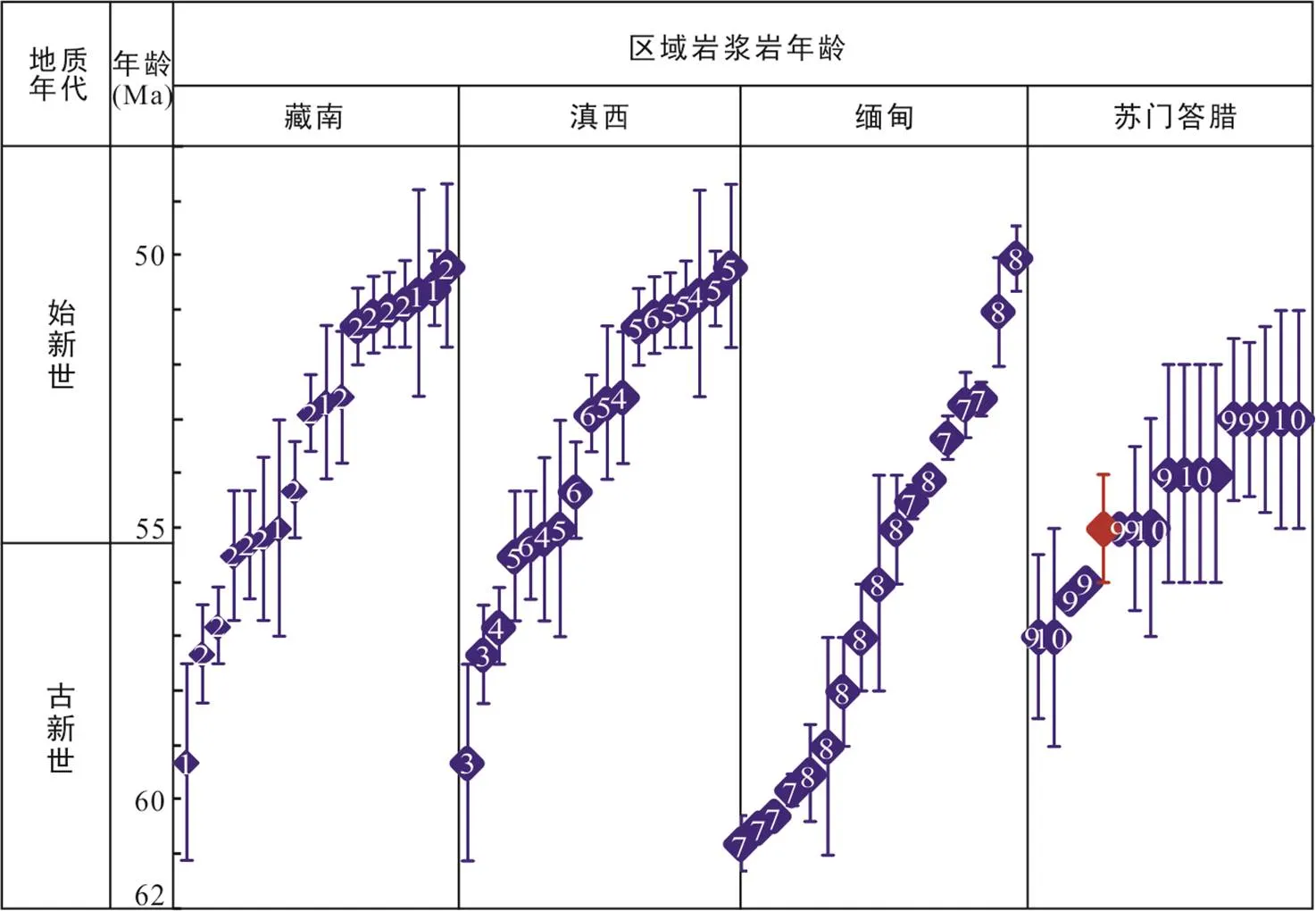
數據來源: 藏南: (1) Wen et al. (2008); (2) Ji et al. (2009); 滇西: (3) Liang et al. (2008); (4) Xu et al. (2012); (5) Ma et al. (2014); (6) Wang et al. (2014); 緬甸: (7) Li et al. (2019); (8) Crow et al. (2017); 蘇門答臘: (9) Cobbing (2005); (10) McCourt et al. (1996); 紅色為本文樣品。
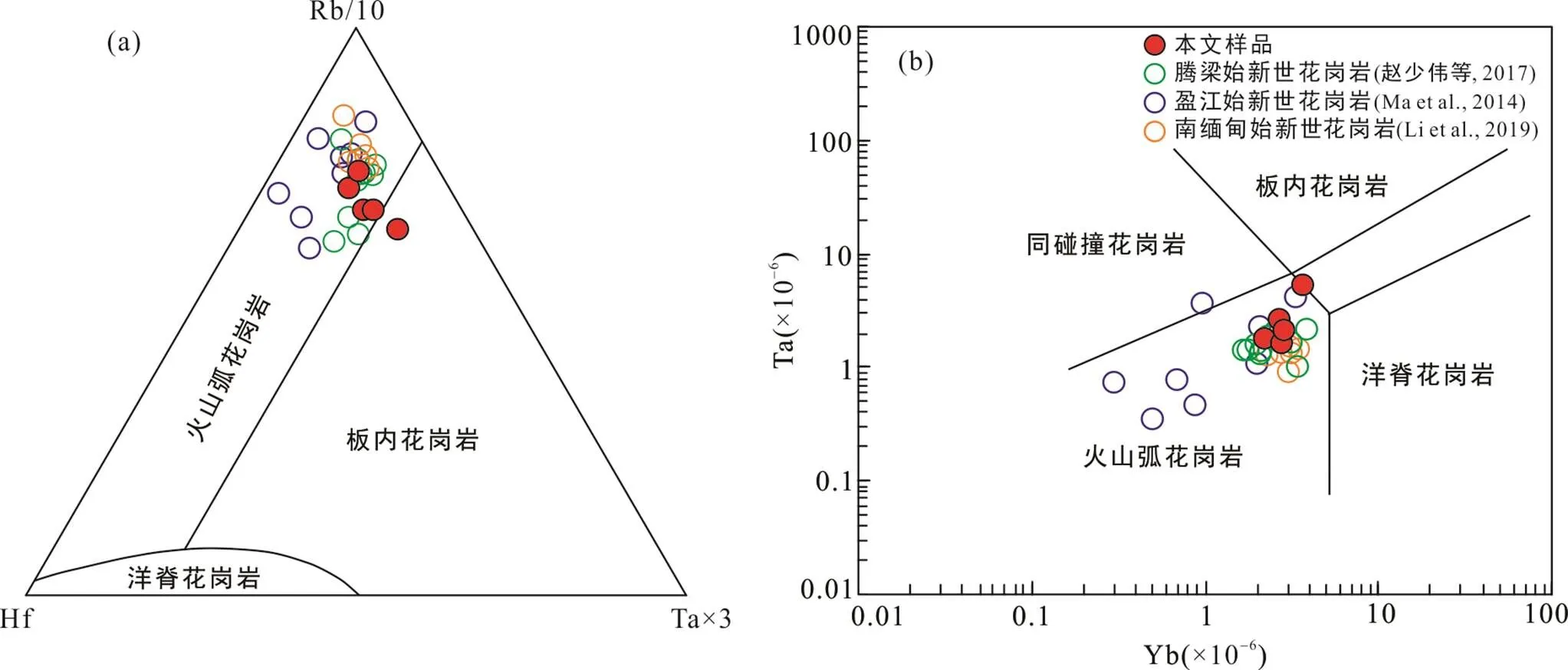
圖11 Panti花崗巖構造背景判別圖解(a據Harris et al., 1986; b據Pearce et al., 1984)
5 結 論
(1) 蘇門答臘島中部Panti地區識別出了早始新世花崗巖, 其鋯石U-Pb年齡為55.5±0.3 Ma(2σ, MSWD=0.87,=30)。
(2) Panti花崗巖為過鋁質的高分異S型花崗巖, 其Hf()為?9.1~?2.6, 二階模式年齡為1.29~1.70 Ga, 地球化學研究表明該套花崗巖為富泥質變沉積巖部分熔融的產物。
(3) Panti花崗巖可以與藏南岡底斯、滇西和緬甸地區的同期花崗巖對比和聯系, 證明了新特提斯洋構造巖漿帶可以向南延伸至蘇門答臘島Panti地區。
致謝:野外樣品采集過程中得到了廣州海洋地質調查局張立敏博士的幫助, 實驗分析中得到了中山大學甘成勢、王玉琨和楊雪博士的幫助, 在此一并致以衷心的感謝。感謝中國地質大學(武漢)徐亞軍教授和另一位匿名審稿專家對該論文提出寶貴的修改意見。
Claisse F and Blanchette J S. 2006. 硼酸鹽熔融的物理與化學: 獻給X射線熒光光譜學工作者. 上海: 華東理工大學出版社: 1–108.
黃玉, 趙志丹, 張鳳琴, 朱弟成, 董國臣, 周肅, 莫宣學. 2010. 西藏岡底斯仁布?拉薩一帶花崗巖基的地球化學及其意義. 巖石學報, 26(10): 3131–3142.
李洪梁, 李光明, 劉洪, 黃瀚霄, 曹華文, 代作文. 2019. 拉薩地體西段達若地區古新世花崗斑巖成因: 鋯石U-Pb年代學、巖石地球化學和Sr-Nd-Pb-Hf同位素的約束. 地球科學, 44(7): 2275–2294.
馬莉燕. 2013. 滇西盈江地區始新世早期巖漿作用成因與構造意義. 廣州: 中國科學院廣州地球化學研究所博士學位論文: 1–87.
馬莉燕, 范蔚茗, 王岳軍, 蔡永豐, 劉匯川. 2013. 那邦地區花崗片麻巖的鋯石U-Pb年代學及Hf同位素組成特征. 大地構造與成礦學, 37(2): 273–283.
阮冰, 駱必繼, 張宏飛, 郭亮, 徐旺春, 趙新福, 張文, 郭京梁. 2019. 西藏岡底斯帶始新世曲水巖基的巖漿混合作用: 來自斜長石陰極發光特征和成分變化的證據. 地球科學, 44(6): 1834–1848.
陶繼華, 李武顯, 李獻華, 岑濤. 2013. 贛南龍源壩地區燕山期高分異花崗巖年代學、地球化學及鋯石Hf-O同位素研究. 中國科學: 地球科學, 43(5): 760–778.
楊啟軍, 徐義剛, 黃小龍, 羅震宇, 石玉若. 2009. 滇西騰沖?梁河地區花崗巖的年代學、地球化學及其構造意義. 巖石學報, 25(5): 86–98.
趙少偉, 賴紹聰, 秦江鋒, 朱韌之, 甘保平. 2017. 騰沖地塊梁河早始新世花崗巖成因機制及其地質意義. 巖石學報, 33(1): 191–203.
周蒂, 顏佳新, 丘元禧, 陳漢宗, 孫珍. 2003. 南海西部圍區中特提斯東延通道問題. 地學前緣, 10(4): 469–477.
朱弟成, 潘桂棠, 莫宣學, 段麗萍, 廖忠禮. 2004. 印度大陸和歐亞大陸的碰撞時代. 地球科學進展, 19(4): 564–571.
朱弟成, 潘桂棠, 王立全, 莫宣學, 趙志丹, 周長勇, 廖忠禮, 董國臣, 袁四化. 2008. 西藏岡底斯帶中生代巖漿巖的時空分布和相關問題的討論. 地質通報, 27(9): 1535–1550.
Advokaat E L, Bongers M L M, Rudyawan A, BouDagher- Fadel M K, Langereis C G and van Hinsbergen D J J. 2018. Early Cretaceous origin of the Woyla Arc (Sumatra, Indonesia) on the Australian plate., 487: 151–164.
Aitchison J C, Ali J R and Davis A M. 2007. When and where did India and Asia collide?, 112B: B05423.
Ballouard C, Poujol M, Boulvais P, Branquet Y, Tartèse R and Vigneresse J L. 2016. Nb-Ta fractionation in peraluminous granites: A marker of the magmatic hydrothermal transition., 44(3): 231–234.
Barber A J. 2000. The origin of the Woyla terranes in Sumatra and the Late Mesozoic evolution of the Sundaland margin., 18(6): 713–738.
Barber A J and Crow M J. 2003. An evaluation of plate tectonic models for the development of Sumatra., 6(1): 1–28.
Barber A J and Crow M J. 2008. The origin and emplacement of the West Burma-West Sumatra ribbon-continent, Proceedings of the International Symposia on GeoscienceResources and Environments of Asian Terranes (GREAT 2008), 4th IGCP.: 24–26.
Barber A J and Crow M J. 2009. Structure of Sumatra and its implications for the tectonic assembly of Southeast Asia and the destruction of Paleotethys., 18(1): 3–20.
Barber A J, Crow M J and De Smet M E M. 2005. Chapter 14: Tectonic evolution // Barber A J, Crow M J and Milsom J S. Sumatra: Geology, Resources and Tectonic Evolution.,,, 31: 234–259.
Barley M E, Pickard A L, Zaw K, Rak P and Doyle M G. 2003. Jurassic to Miocene magmatism and metamorphism in the Mogok metamorphic belt and the India-Eurasia collision in Myanmar., 22(3), https: //doi.org/ 10.1029/2002TC001398.
Bertrand G, Rangin C, Maluski H, Bellon H and Party G S. 2001. Diachronous cooling along the Mogok MetamorphicBelt (Shan scarp, Myanmar): The trace of the northwardmigration of the Indian syntaxis., 19(5): 649–659.
Bertrand G, Rangin C, Maluski H, Han T A, Thein M, Myint O, Maw W and Lwin S. 1999. Cenozoic metamorphism along the Shan scarp (Myanmar): Evidences for ductile shear along the Sagaing fault or the northward migration of the eastern Himalayan syntaxis?, 26(7): 915–918.
Boehnke P, Watson E B, Trail D, Harrison T M and Schmitt A K. 2013. Zircon saturation re-revisited., 351: 324–334.
Cameron N R, Clarke M C G, Aldiss D T, Aspden J A and Djunuddin A. 1980. The geological evolution of northernSumatra.,9th,: 149–187.
Chu M F, Chung S L, Song B A, Liu D Y, O’Reilly S Y, Pearson N J, Ji J Q and Wen D J. 2006. Zircon U-Pb and Hf isotope constraints on the Mesozoic tectonics and crustal evolution of southern Tibet., 34(9): 745–748.
Chung S L, Chu M F, Zhang Y Q, Xie Y W, Lo C H, Lee T Y, Lan C Y, Li X H, Zhang Q and Wang Y Z. 2005. Tibetan tectonic evolution inferred from spatial and temporal variations in post-collisional magmatism., 68(3–4): 173–196.
Cobbing E J. 2005. Chapter 5: Granites // Barber A J, Crow M J and Milsom J S. Sumatra: Geology, Resources and Tectonic Evolution.,,, 31: 54–62.
Cobbing E J, Pitfield P E J, Darbyshire D P F and Mallick D I J. 1992. The granites of the Southeast Asian tin belt.,: 10.
Crow M J and Khin Z. 2017. Appendix Geochronology in Myanmar (1964–2017).,,, 48(1): 713–759.
Ding L, Kapp P and Wan X Q. 2005. Paleocene-Eocene record of ophiolite obduction and initial India-Asia collision, south central Tibet.: 24(3), TC3001.
Garzanti E. 2008. Comment on “When and where did India and Asia collide?” by Jonathan C. Aitchison, Jason R. Ali, and Aileen M. Davis., 113(B4), B04411.
Griffin W L, Pearson N J, Belousova E, Jackson S E, van Achterbergh E, O’Reilly S Y and Shee S R. 2000. The Hf isotope composition of cratonic mantle: LAM-MC- ICPMS analysis of zircon megacrysts in kimberlites., 64(1): 133–147.
Griffin W L, Powell W J, Pearson N J and O’Reilly S Y. 2008. GLITTER: Data reduction software for laser ablation ICP-MS // Sylvester P. Laser Ablation-ICP-MS in the Earth Sciences., 40: 204–207.
Griffin W L, Wang X, Jackson S E, Pearson N J, O’Reilly S Y, Xu X S and Zhou X M. 2002. Zircon chemistry and magma mixing, SE China:analysis of Hf isotopes, Tonglu and Pingtan igneous complexes., 61(3–4): 237–269.
Hall R. 2012. Late Jurassic-Cenozoic reconstructions of the Indonesian region and the Indian Ocean., 570–571: 1–41.
Hamilton W B, 1979. Tectonics of the Indonesian region. Washington: United States Government Printing Office: 1–345.
Harris N B W and Ingcr S. 1991. Trace element modelling of pelite-derived granites., 110: 46–56.
Harris N B W, Pearce J A and Tindle A G. 1986. Geochemical characteristics of collision zone magmatism.,,, 19: 67–81.
Hu Z C, Liu Y S, Gao S, Liu W G, Zhang W, Tong X R, Lin L, Zong K Q, Li M, Chen H H, Zhou L and Yang L. 2012. ImprovedHf isotope ratio analysis of zircon using newly designed X skimmer cone and jet sample cone in combination with the addition of nitrogen by laser ablation multiple collector ICP-MS., 27(9): 1391– 1399.
Ji W Q, Wu F Y, Chung S L, Li J X and Liu C Z. 2009. Zircon U-Pb geochronology and Hf isotopic constraints on petrogenesis of the Gangdese batholith, southern Tibet., 262(3–4): 229–245.
Ji W Q, Wu F Y, Liu C Z and Chung S L. 2012. Early Eocene crustal thickening in southern Tibet: New age and geochemical constraints from the Gangdese batholith., 53: 82–95.
Jiang H, Li W Q, Jiang S Y, Wang H and Wei X P. 2017. Geochronological, geochemical and Sr-Nd-Hf isotopic constraints on the petrogenesis of Late Cretaceous A-type granites from the Sibumasu Block, Southern Myanmar, SE Asia., 268: 32–47.
Jiang Y H, Zhao P, Zhou Q, Liao S Y and Jin G D. 2011. Petrogenesis and tectonic implications of Early Cretaceous S- and A-type granites in the northwest of the Gan-Hang rift, SE China., 121(1–4): 55–73.
Jung S and Pfander J A. 2007. Source composition and melting temperatures of orogenic granitoids: Constraints from CaO/Na2O, Al2O3/TiO2and accessory mineral saturation thermometry., 19(6): 859–870.
Katili J A. 1973. Geochronology of West Indonesia and its implication on plate tectonics., 19(3): 195–212.
Khan P K, Shamim S, Mohanty M, Kumar P and Banerjee J. 2017. Myanmar-Andaman-Sumatra subduction margin revisited: Insights of arc-specific deformations., 28(4): 683–694.
King P L, White A J R, Chappell B W and Allen C M. 1997. Characterization and origin of aluminous A-type granites from the Lachlan Fold Belt, southeastern Australia., 38(3): 371–391.
Klootwijk C T, Gee J S, Peirce J W, Smith G M and McFadden P L. 1992. An early India-Asia contact: Paleomagnetic constraints from Ninetyeast Ridge, ODP Leg 121., 20: 395–398.
Koester E, Pawley A R, Fernandes L A D, Porcher C C and Soliani E. 2002. Experimental melting of cordierite gneiss and the petrogenesis of syntranscurrent peraluminous granites in southern Brazil., 43(8): 1595–1616.
Lee H Y, Chung S L, Ji J, Qian Q, Gallet S, Lo C H, Lee T Y and Zhang Q. 2012. Geochemical and Sr-Nd isotopic constraints on the genesis of the Cenozoic Linzizong volcanic successions, southern Tibet., 53: 96–114.
Leech M L, Singh S, Jain A, Klemperer S L and Manickava-sagam R. 2005. The onset of India-Asia continental collision: Early, steep subduction required by the timing of UHP metamorphism in the western Himalaya., 234(1–2): 83–97.
Li J X, Fan W M, Zhang L Y, Evans N J, Sun Y L, Ding L, Guan Q Y, Peng T P, Cai F L and Sein K. 2019. Geochronology, geochemistry and Sr-Nd-Hf isotopic compositions of Late Cretaceous-Eocene granites in southern Myanmar: Petrogenetic, tectonic and metallogenic implications., 112: 1–16.
Liang Y H, Chung S L, Liu D Y, Xu Y G, Wu F Y, Yang J H, Wang Y and Lo C H. 2008. Detrital zircon evidence from Burma for reorganization of the eastern Himalayan river system., 308(4): 618–638.
Lin I J, Chung S L, Chu C H, Lee H Y, Gallet S, Wu G Y, Ji J Q and Zhang Y Q. 2012. Geochemical and Sr-Nd isotopic characteristics of Cretaceous to Paleocene granitoids and volcanic rocks, SE Tibet: Petrogenesis and tectonic implications., 53: 131– 150.
Liu C Z, Chung S L, Wu F Y, Zhang C, Xu Y, Wang J G, Chen Y and Guo S. 2016. Tethyan suturing in Southeast Asia: Zircon U-Pb and Hf-O isotopic constraints from Myanmar ophiolites., 44(4): 311–314.
Ma L Y, Wang Y J, Fan W M, Geng H Y, Cai Y F, Zhong H, Liu H C and Xing X W. 2014. Petrogenesis of the early Eocene I-type granites in west Yingjiang (SW Yunnan) and its implication for the eastern extension of the Gangdese batholiths., 25(1): 401–419.
McCourt W J, Crow M J, Cobbing E J and Amin T C. 1996. Mesozoic and Cenozoic plutonic evolution of SE Asia: evidence from Sumatra, Indonesia // Hall R and Blundell DJ. Tectonic Evolution of Southeast Asia., 106(15): 321–335.
Metcalfe I. 1993. Southeast Asian terranes: Gondwanaland origins and evolution // Findlay R H, Unrug R, Banks, M R and Veevers J J. Gondwana 8-Assembly, Evolution, and Dispersal (Proceedings Eighth Gondwana Symposium, Hobart, 1991). Rotterdam: A.A. Balkema Publishers: 181–200.
Metcalfe I. 1996. Pre-Cretaceous evolution of SE Asian terranes.,,, 106(1): 97–122.
Metcalfe I. 2011. Tectonic framework and Phanerozoic evolution of Sundaland., 19(1): 3–21.
Metcalfe I. 2013. Gondwana dispersion and Asian accretion: Tectonic and palaeogeographic evolution of eastern Tethys., 66: 1–33.
Mitchell A, Chung S L, Oo T, Lin T H and Hung C H. 2012. Zircon U-Pb ages in Myanmar: Magmatic-metamorphic events and the closure of a neo-Tethys ocean?, 56: 1–23.
Mitchell A, Htay M T, Htun K M, Win M N, Oo T and Hlaing T. 2007. Rock relationships in the Mogok metamorphic belt, Tatkon to Mandalay, central Myanmar., 29(5–6): 891–910.
Mitchell A H G. 1993. Cretaceous-Cenozoic tectonic events in the western Myanmar (Burma)-Assam region., 150: 1089–1102.
Najman Y, Appel E, Boudagher-Fadel M, Bown P, Carter A, Garzanti E, Godin L, Han J T, Liebke U, Oliver G, Parrish R and Vezzoli G. 2010. Timing of India-Asia collision: Geological, biostratigraphic, and palaeomagneticconstraints.:, 115(B12).
Pearce J A, Harris N B W and Tindle A G. 1984. Trace element discrimination diagrams for the tectonic interpretation of granitic rocks., 25(4): 956–983.
Sarma D S, Jafri S, Fletcher I R and McNaughton N J. 2010. Constraints on the tectonic setting of the Andaman ophiolites, Bay of Bengal, India, from SHRIMP U-Pb zircon geochronology of plagiogranite., 118(6): 691–697.
Searle M P, Noble S R, Cottle J M, Waters D J, Mitchell A H G, Hlaing T and Horstwood M S A. 2007. Tectonic evolution of the Mogok metamorphic belt, Burma (Myanmar) constrained by U-Th-Pb dating of metamorphic and magmatic rocks., 26(3): 1–24.
S?derlund U, Patchett P J, Vervoort J D and Isachsen C E. 2004. The176Lu decay constant determined by Lu-Hf and U-Pb isotope systematics of Precambrian mafic intrusions., 219(3–4): 311–324.
Sun S S and McDonough W F. 1989. Chemical and isotopic systematics of oceanic basalts: Implications for mantle composition and processes.,,, 42(1): 313–345.
Sylvester P J. 1998. Post-collisional strongly peraluminous granites., 45(1): 29–44.
Wajzer M R, Barber A J and Hidayat S. 1991. Accretion, collision and strike-slip faulting: The Woyla Group as a key to the tectonic evolution of North Sumatra., 6(3–4): 447–461.
Wang J G, Hu X M, Jansa L B and Huang Z C. 2011. Provenance of the Upper Cretaceous-Eocene deep-water sandstones in Sangdanlin, Southern Tibet: Constraints on the timing of initial India-Asia collision., 119(3): 293–309.
Wang J G, Wu F Y, Tan X C and Liu C Z. 2014b. Magmatic evolution of the Western Myanmar Arc documented by U-Pb and Hf isotopes in detrital zircon., 612: 97–105.
Wang Y J, Qian X, Cawood P A, Liu H C, Feng Q L, Zhao G C, Zhang Y H, He H Y and Zhang P Z. 2018. Closure of the East Paleotethyan Ocean and amalgamation of the Eastern Cimmerian and Southeast Asia continental fragments., 186: 195–230.
Wang Y J, Zhang L M, Cawood P A, Ma L Y, Fan W M, Zhang A M, Zhang Y Z and Bi X W. 2014. Eocene supra-subduction zone mafic magmatism in the SibumasuBlock of SW Yunnan: Implications for Neotethyan subduction and India-Asia collision., 206: 384–399.
Wen D R, Liu D Y, Chung S L, Chu M F, Ji J Q, Zhang Q, Song B, Lee T Y, Yeh M W and Lo C H. 2008. Zircon SHRIMP U-Pb ages of the Gangdese Batholith and implications for Neotethyan subduction in southern Tibet., 252(3–4): 191–201.
Whalen J B, Currie K L and Chappell B W. 1987. A-type granites: Geochemical characteristics, discrimination and petrogenesis., 95(4): 407–419.
Wolf M B and London D. 1994. Apatite dissolution into peraluminous haplogranitic melts: An experimental study of solubilities and mechanisms., 58(19): 4127–4145.
Wu F Y, Huang B C, Ye K and Fang A M. 2008. Collapsed Himalayan-Tibetan orogen and rising Tibetan Plateau., 24(1): 1–30.
Xu Y G, Yang Q J, Lan J B, Luo Z Y, Huang X L, Shi Y R and Xie L W. 2012. Temporal-spatial distribution and tectonic implications of the batholiths in the Gaoligong- Tengliang-Yingjiang area, western Yunnan: Constraints from zircon U-Pb ages and Hf isotopes., 53: 151–175.
Yin A and Harrison T M. 2000. Geologic evolution of the Himalayan-Tibetan orogen., 28(1): 211–280.
Zaw K. 1990. Geological, petrogical and geochemical chara-cteristics of granitoid rocks in Burma: With special reference to the associated W-Sn mineralization and their tectonic setting., 4(4): 293–335.
Zen E A. 1986. Aluminum enrichment in silicate melts by fractional crystallization: Some mineralogic and petro-gra-phic constraints., 27(5): 1095– 1117.
Zeng L S, Gao L E, Xie K J and Liu J. 2011. Mid-Eocene high Sr/Y granites in the Northern Himalayan Gneiss Domes: Melting thickened lower continental crust., 303(3–4): 251–266.
Zhang P, Mei L F, Hu X L, Li R Y, Wu L L, Zhou Z C and Qiu H N. 2017. Structures, uplift, and magmatism of the Western Myanmar Arc: Constraints to mid-Cretaceous- Paleogene tectonic evolution of the western Myanmar continental margin., 52: 18–38.
Zhang X R, Chung S L, Lai Y M, Ghani A A, Murtadha S, Lee H Y and Hsu C C. 2019. A 6000-km-long Neo-Tethyan arc system with coherent magmatic flare-ups and lulls in South Asia., 47(6): 573–576.
Zhu D C, Wang Q, Zhao Z D, Chung S L, Cawood P A, Niu Y, Liu S A, Wu F Y and Mo X X. 2015. Magmatic record of India-Asia collision., 5: 14289.
Zhu D C, Zhao Z D, Niu Y L, Mo X X, Chung S L, Hou Z Q, Wang L Q and Wu F Y. 2011. The Lhasa Terrane: Record of a microcontinent and its histories of drift and growth., 301(1–2): 241–255.
Geochemical Characteristics of the Early Eocene S-type Granites in Panti, Central Sumatra and its Neotethyan Tectonic Implications
YU Xiaoqing1, 2, QIAN Xin1, 2*, ZHANG Yuzhi1, 2, XU Chang1, 2and WANG Yuejun1, 2
(1. Guangdong Key Lab of Geodynamics and Geohazards, School of Earth Sciences and Engineering, Sun Yat-sen University, Guangzhou 510275, Guangdong, China; 2. Southern Marine Science and Engineering Guangdong Laboratory, Zhuhai 519082, Guangdong, China)
The Sumatra Island, which is located in the tectonic junction of the Tethyan domain and the Indian Ocean subduction zone, has widespread outcrops of Meso-Cenozoic igneous rocks. These igneous rocks are important to constrain the extension of the Tethys tectonic belt in Sumatra, but remain poorly studied. In this paper, we present a set of petrographic, zircon U-Pb geochronological, zirconHf isotopic, and whole-rock geochemical data for the granites from the Panti area in the central Sumatra. LA-ICP-MS zircon U-Pb dating showed that the Panti granites were crystallized at 55.5±0.3 Ma. The Panti granites have high SiO2(76.61%–78.37%), high alkali (Na2O+K2O=7.47%–8.21%), differentiation index (DI) (95–96), and A/CNK (1.08–1.12) values, indicative of highly fractionated S-type granite. The granites are characterized by significant negative Eu anomalies (Eu/Eu*=0.04–0.05) and depletion of Nb, Ta, Sr, P, and Ti. The high Rb/Sr and low CaO/Na2O ratios, along with the negativeHf() values (?9.1 to ?2.6) and oldDM2ages (1.29–1.70 Ga) indicate that the granites were derived from partial melting of ancient pelitic-rich metasediments. The early Eocene granites in the Panti area have geochemical features similar to those of the Tengliang and Yingjiang areas in Western Yunnan. Therefore, it is suggested that the Neotethyan belt southerly extend to the central Sumatra.
central Sumatra; early Eocene; highly fractionated S-type granite; zircon U-Pb dating; geochemistry; Neotethys
2020-01-16;
2020-05-04
國家自然科學基金項目(41830211、U1701641、42072256)、國家重點研發計劃項目(2016YFC0600303)和廣東省基礎與應用基礎研究基金項目(2018B030312007、2019B1515120019)聯合資助。
余小清(1994–), 女, 碩士研究生, 地球化學專業。Email: yuxq9@mail2.sysu.edu.cn
錢鑫(1988–), 男, 副教授, 從事東南亞大地構造研究。Email: qianx3@mail.sysu.edu.cn
P597
A
1001-1552(2021)03-0570-016
10.16539/j.ddgzyckx.2021.03.007

